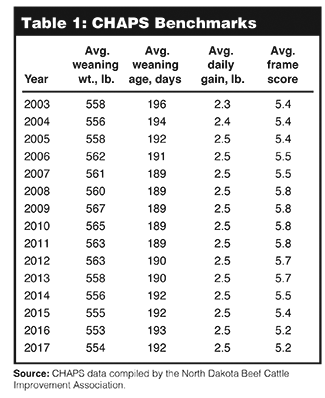
Kris Ringwall
Beef Talk
Stability seen in long-term trends for beef growth performance.
The North Dakota State University (NDSU) Extension Service and North Dakota Beef Cattle Improvement Association (NDBCIA) collect and analyze data through Cow Herd Appraisal of Performance Software (CHAPS) to produce meaningful annual benchmarks. The current growth benchmark for actual weaning weight is 554 pounds (lb.) at 192 days of age, with an average daily gain of 2.5 lb. These calves are a 5.2 frame score.
The NDBCIA uses the CHAPS program to calculate five-year rolling benchmark values for average herd performance. Those values have been quite consistent. Let’s look closer at the average actual weaning weight benchmark.
 Historically (10-plus years ago), the benchmark was 558 lb. for 2003, 556 lb. for 2004, 558 lb. for 2005, 562 lb. for 2006 and 561 lb. for 2007. In 2008, the benchmark was 560 lb., and it was 567 lb. in 2009, 565 lb. in 2010, 563 lb. in 2011 and 563 lb. in 2012. More recently, the benchmark was 558 lb. in 2013, 556 lb. in 2014, 555 lb. in 2015 and 553 lb. in 2016. The 2017 benchmark is 554 lb. Not much has changed in commercial beef production in terms of fall weaning weights.
Historically (10-plus years ago), the benchmark was 558 lb. for 2003, 556 lb. for 2004, 558 lb. for 2005, 562 lb. for 2006 and 561 lb. for 2007. In 2008, the benchmark was 560 lb., and it was 567 lb. in 2009, 565 lb. in 2010, 563 lb. in 2011 and 563 lb. in 2012. More recently, the benchmark was 558 lb. in 2013, 556 lb. in 2014, 555 lb. in 2015 and 553 lb. in 2016. The 2017 benchmark is 554 lb. Not much has changed in commercial beef production in terms of fall weaning weights.
The benchmark for age at weaning has fluctuated a little. Historically (10-plus years ago), the benchmark was 196 days of age for 2003, 194 days of age for 2004, 192 days of age for 2005, 191 days of age for 2006 and 189 days of age for 2007. The weaning age benchmark remained at 189 days for 2008, 2009, 2010 and 2011, and increased to 190 days of age for 2012 and 2013, 192 days of age for 2014 and 2015, and 193 days of age for 2016. The 2017 benchmark is back at 192 days of age at weaning.
This translates into fairly consistent average daily gain (ADG) benchmarks, starting at 2.3 lb. per day in 2003 and 2.4 lb. per day in 2004. Remarkably, the ADG benchmark has been 2.5 lb. per day from 2005 through 2017. Interesting.
The frame score benchmark, although not a growth number, is indicative of the calf’s frame size and has been quite consistent, as well. Ten-plus years ago, the benchmark was 5.4 for 2003, 2004 and 2005; and 5.5 for 2006 and 2007. The benchmark for 2008 increased to 5.8 and remained at 5.8 for 2009, 2010 and 2011. In 2012 and 2013, the annual frame score benchmark declined to 5.7. It declined to 5.5 in 2014 and to 5.4 in 2015. It further declined to 5.2 in 2016. The 2017 frame score benchmark is still at 5.2.
Perhaps the commercial beef cattle business could be called mature, at least for growth on the cow-calf side of the business.
Target performance level
A producer needs to decide what level of performance is expected and how much one is willing to expend to get that performance. Performance is really herd output, a function of age and growth. The benchmarks provide a tool for herd evaluation, a review of growth annual trends and a number on which to base future goals for the operation.
Interestingly, producers continue to market cattle with considerable growth potential, based on current trends for expected progeny difference (EPDs) within available herd sires. They’re actually selling calves at historical weights, thus allowing the feeding industry to capture the additional growth potential bred into the cattle.
Historical marketing brings comfort to established cow-calf programs, but, yes, there is a “but.” Historical marketing programs apparently do not allow for expression and payback for the growth potential that is hidden within the phenotypes of the calves brought for sale.
Ironically, the heifer mates to these cattle are retained at home. The heifers grow into cows, and their mature weight naturally would be similar to the steers that were sent to the feedlot.
They have gotten bigger. So producers face some challenges: growth genetics that are not being captured as the progeny are marketed and subsequent larger mother cows that cost more to keep. The real answer to the management of growth genetics needs to return to where it started, which is sound breeding systems combined with more flexibility in the marketing of the offspring.
Historically, breeding systems were intended to allow producers to maintain the most efficient maternal cow at home, purchase good terminal-type sires and produce a terminal offspring that was intended for the feedyard. At some point, another breeding system would be utilized to produce the replacement female; thus, the best of both worlds.
Cattle breeding systems with additional marketing options may well be the better answer. Producers need to implement terminal and maternal breeding systems with additional marketing flexibility.
May you find all your ear tags.
Editor’s Note: Kris Ringwall is a beef specialist for the North Dakota State University Extension Service. For more information, contact your local NDSU Extension Service agent (https://www.ag.ndsu.edu/extension/directory) or Ringwall at the Dickinson Research Extension Center, 1041 State Ave., Dickinson, ND 58601; 701-456-1103; or kris.ringwall@ndsu.edu.







